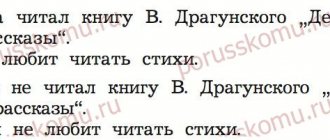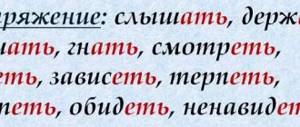Lesson summary and presentation on the topic “The Concept of Communion”; 7th grade
Lets Yulia Anatolyevna, teacher of Russian language and literature, MBOU secondary school No. 27 with in-depth study of aesthetic subjects in Tver
Lesson summary in Russian language
Topic: “The concept of communion”
Objectives: to give the concept of participle as a part of speech; teach to identify participles in the text; formulate articulatory skills in pronouncing participles.
Equipment: educational complex “Russian language. Theory. 5-9 grades.” V.V. Babaytseva, L.D. Chesnokova; "Russian language. Practice. 7th grade” / ed. S.N. Pimenova.
During the classes
- Organizing time.
- Checking homework.
- Writing with the whole class a vocabulary dictation compiled by one of the students.
Admiral, academy, alley, accordion, apparatus, library, interior, colleague, gallery, corridor, worker, art, feel, participate, study, staircase.
- Studying a new topic.
- Syntax five minutes.
A proposal is written on the board. There are no punctuation marks. Letters are missing.
(To) morning before...it's past...l_ but the sky is still... (in) thick...yellow gray clouds...
flying (from) south to north.
Open the brackets, underline and explain the spellings. Determine which part of speech the words belong to. Parse the sentence. One student goes to the board, the rest do it in their notebooks.
- Statement of a problematic question.
Why did the highlighted word make you wonder what part of speech it belongs to?
The teacher listens to the students' opinions.
What parts of speech can this word be classified as and why? (to an adjective - on a question; to a verb, because it denotes an action).
- Formulating the topic and objectives of the lesson.
The part of speech, guys, that combines the characteristics of an adjective and a verb is called a “participle.” Let's write down the topic of our lesson and try to formulate goals for it.
Writing in notebooks. The teacher listens to the goals formulated by the students (learn about the participle as a part of speech; teach to recognize participles in the text)
.
- Introductory task (exercise 40).
Look carefully at the picture. What objects (persons) and what actions are performed on it? ( a boy is reading a book, a ball is under the table, a girl is playing with toys, etc.
).
Make up several synonymous phrases based on the example:
a boy who reads - a boy who reads...
(the ball that is lying is a lying ball; a girl who plays - a girl who plays, etc.
).
How did you experience the peculiarity of the sacrament? What does it consist of?
(Identify a sign by its action
).
- Didactic exercise “Characterize an object by drawing”
The slide shows 2 pictures of the options:
option I – dad repairs a chair;
option II - the girl draws a doll.
Students are asked to use participles to characterize an object that produces an action and an object that experiences an action from another object. (Dad repairing a chair; a chair being repaired by dad; a girl drawing a doll; a doll being drawn by a girl.)
Pay attention to the suffixes that form participles. Introduction of the concept of passive and active participles.
- Practical work according to the textbook (exercises 39, 41).
- Consolidation of theoretical information (paragraph 139).
- Summing up the lesson.
- Answers on questions:
- What parts of speech does the participle have?
- What is special about the sacrament?
- What is the difference between active and passive participle?
- Assessing active students in the classroom.
- Reflection.
- Homework: paragraph 132 (“Theory”), ex. 42 (“Practice”).
Download material
so UNT / Lesson plans for the Russian language / Lesson plans for the Russian language 7th grade
Lesson 18. Participle as part of speech
14.12.2011 35233 3021
PARTICIPLE
Lesson 18. Participle as a part of speech
Objectives:
give the concept of participle as a part of speech; show the connection of the participle with the adjective and with the verb; develop students' logical thinking.
Methodical techniques:
teacher explanations, exercises, vocabulary work.
During the classes
I. Checking homework
Reading and discussion of essays (1-2 essays on each topic).
II. Explanation of the topic “Communion as a part of speech”
Teacher's word.
We continue to study a large topic - “Morphology and Spelling”. In previous classes, we studied nominal parts of speech: noun, adjective, numeral, pronoun - and another important independent part of speech - the verb. The parts of speech that we have to study for about two quarters are closely related to the verb. We are talking about participles and gerunds. As you can see, these parts of speech are similar in sound. Their main similarity is their undoubted connection with the verb.
Let us immediately note that a significant part of linguistic scientists and linguists consider the participle and the gerund to be not independent
parts of speech, but special forms of the verb. In the process of studying, we will try to find arguments in favor of both points of view. Of course, you are entitled to your opinion on this linguistic issue. But this requires a deep study of the issue.
So, let's start a new topic - “Communion”.
Let's look at an expressive example given in the textbook.
III. Working with the textbook
1. Reading §9 (p. 24).
2. Discussion of issues.
Note that both words: volatile
and
flying -
indicate the characteristics of objects, answer the same question (which one?) and differ only in one letter. Let's think about the meaning of these definitions.
The word volatile
denotes a permanent feature of an object. This feature is always inherent in tree seeds; it is a constant property of seeds, their feature. We cannot say the same about stone. The permanent property of the stone is immobility. It will fly, and only for a while, only if it is thrown or if it is pushed, say, by an avalanche.
—What are tree seeds called? What are they? (Volatile.)
- What do you call a stone that flies? What is he like? (Flying.)
In the first case, we have an adjective definition. In
the second is a participle definition.
— What are the similarities between an adjective and a participle? (They answer
the same question, indicate the attribute of the object.)
- What is the difference? (An adjective denotes a permanent
attribute of an object. A participle denotes a attribute of an object by action, and this attribute does not appear constantly, but over time. The participle can be replaced by a phrase: the one who does something or the one with whom they do (did) something. )
The action can be produced by the object itself: a working computer
(the one that works);
smiling
child (one who smiles);
ongoing conversation
(one that continues), etc.
But the action is not always produced by the object itself. Sometimes an action is performed on him: a made-up story
(the one that someone came up with);
being solved
(the one that someone is solving);
turned on TV
(the one that someone turned on).
3. Exercise:
select examples of participles, prove that the word belongs to participles.
IV. Doing exercises
1. Exercise 52. Observations, answers to questions, conclusion - the participle changes in the same way as an adjective, and depends on the noun to which it refers.
2. Exercise 53. Find the signs of the verb in the participle and draw the conclusion:
Participles, like verbs, have present and past tense forms.
Additional question:
—Can a participle be in the future tense? Why? The conclusion is obvious: it can’t. The participle has no future tense: it is a sign of action in
the future does not exist.
3. Exercise 54: expressive reading, writing on the board and in
notebooks.
We ask questions about participles, we emphasize them as definitions: sleeping, spending the night, whitening,
4. Exercise 55: reading theoretical material on p. 25 I and
its discussion.
5. Exercise 56: expressive reading, determining style;" text (art), independent work (written).
‘ Homework
1.§9.
2. Exercise 57.
3. Bring any recent newspaper or magazine to class.
See the downloadable file for the full text of the material.
The page contains only a fragment of the material.
Russian language lesson in 7th grade on the topic: “Communion as a part of speech” - presentation
Russian language lesson in 7th grade on the topic: “Communion as a part of speech”
Methods and techniques: verbal (conversation, explanation, introduction to the rule); practical (independent work, working with task cards); method of differentiated knowledge testing; visual (illustrations, cards); partially search. Lesson forms: frontal, work in pairs, individual work, mutual testing, self-testing, independent work, differentiated work. Equipment: interactive whiteboard; multimedia slides; Handout; textbook "Russian language". 7th grade. M.T. Baranov, T.A. Ladyzhenskaya, L.A. Trostentsova and others. M., Education, 2011.
p/n Lesson stage Time, min. 1Organizational moment 2 min 2Updating knowledge 5 min 3Learning new material 13 min 4Formation of new knowledge 7 min 5Applying new knowledge and skills 9 min 6Systematizing knowledge 4 min 7Homework assignment 2 min 8Summarizing and reflection 3 min
I. Organizational point: prepare students for work in the lesson, greeting, checking absentees, recording the date. During the classes.
II. Updating knowledge: create a situation of success and a positive emotional mood, update students’ basic knowledge, prepare students’ thinking to create a new way of action. Teacher: Guys, I really want our lesson to be interesting and educational. In this lesson we will try to discover new secrets of the Russian language. Today you will learn an amazing story about homeless suffixes that have found their place. We will get acquainted with a part of speech that is new to you, and consider how it is formed. To do this, we recall the morphological features of the adjective.
Let's fill in the clusters: adjective verb Question: which one? which? which one? which? Form: full and short Gender, number, case Type Tense
Teacher: -Knowledge about these parts of speech will be useful to us in determining the part of speech that we will talk about. For what purpose do you think we remembered these signs? Student: -The part of speech that will be discussed has the characteristics of a verb and an adjective. Teacher: -In this regard, determine what goal is facing you in the lesson? Student: -Learn a new part of speech, its morphological features. Student: - Determine the distinctive features of this part of speech.
III. Studying new material (introduce new material). Teacher: To achieve the goals we have set, I invite you to go on a linguistic journey. In the thirtieth kingdom, in the thirtieth state Morphology, there lived a king. One day he gathered his subjects to a ball. Verbs and Adjectives arrived at the palace. But for some reason the start of the appointment was delayed. It turned out that unfamiliar guests approached the king with a complaint about his homeless life. The king looked at them carefully and did not recognize them, only the suffix -enn- was familiar to him. doing loving read carried illuminated persecuted read seen shaved
- Guys, are you familiar with this suffix? Of those who arrived at the palace, which part of speech does he belong to? Student: The suffix -enn- belongs to the adjective. Teacher: The guests began to ask the King of Morphology to assign them to some part of speech. The kindly verbs immediately volunteered to help. They ran up to the strangers and said: “We will give you the most precious thing we have - the foundation, and you will be a piece of our heart.” And the kind wizard Adjective also wanted to help the unfortunate and gave them endings. And these are the words that came out. Let's read and write them in a notebook. Do doing Love loving Read read Carry carried Illuminate illuminated Drive persecuted Read read See seen Shave shaved
Teacher: - It turned out to be an independent part of speech. And they called it communion. So, let’s write down the topic of our lesson “Communion as a part of speech.” On the board, read what V.I. Dal, the author of the famous “Explanatory Dictionary of the Living Great Russian Language,” said about participles. Student: - “The part of speech involved in the verb, in the form of an adjective.” Teacher: - V.I. Dahl paid attention not only to the content, but also to the form of the participle, since in its “appearance” it really resembles an adjective. Write down this statement.
Part of speech involved in the verb, Part of speech involved in the verb, in the form of an adjective. in the form of an adjective. IN AND. Dahl. IN AND. Dahl.
Teacher: - Since the participle resembles an adjective, let's remember what we know about the adjective? By what signs do we distinguish an adjective from other parts of speech? Let's turn to the compiled clusters. Are these signs suitable for communion? Let's continue working on the textbook. Find the common features of an adjective and a participle. Read paragraph 9 aloud and work in pairs.
Work in pairs Adjective name little boy 1. Question: which 2. Attribute of the object 3. Initial form: im. p., units h., m.r. 4. Changes according to gender, cases, numbers (little girl, little boy, little boys) 5. Endings –i, -aya, -ogo, -ie. Communion reading boy 1. Question: which 2. Attribute of an object by action 3. Initial form: im. p., units h., m.r. 4. Changes according to gender, cases, numbers (reading girl, reading boy, reading boys) 5. Endings -i, -aya, -ogo, -ie. Conclusion (done by the student): The participle has the characteristics of an adjective.
Work in pairs Verb loves 1. Action of the subject 2. Time (present) 3. Aspect (not present) 4. Reflexivity (dung v.) 5. Dependent words (loves whom?) Participle loving 1. Attribute of the subject by action 2. Time (present) 3. Aspect (non-sov.) 4. Reflexivity (dung v.) 5. Dependent words (loving whom?) Conclusion (done by the student): The participle is also similar to a verb, only it has 2 tenses: present and past .
adjective 1. Which one? Which? Which one? 2. Indicates a feature of an object 3. Initial form: im.p., units. h., m.r. 4. Changes by gender, number and case. 5. The main word is a noun (consistent in gender, number, case). 6. Endings: aya-yaya, ee-ee, yu-yu... verbs 1. Indicates the attribute of an object by action 2. Changes according to tenses (present, past). 3. Looks like (owl., non-sov.)4. There is a postfix – xia. The participle combines signs
Teacher: Based on this diagram and the material in the paragraph, define participle. Student: PARTICIPLE: This is an independent part of speech that denotes the attribute of an object by action and answers the questions: what? which? which one? which? Participles come in perfect and imperfect forms. They change according to tenses, numbers and cases.
Let's learn the participle Let's learn the participle From the verb (you can say “the one that ...") Flying - the one who flies Teacher: - Guys, I’ll tell you the secrets of the participle. To make it easier to recognize participles among other parts of speech, remember the suffixes.
IV. Formation of new skills. Teacher: -Let's see who has a good memory. Within 1 minute you need to remember the suffixes and then write them down in your notebook. (Mutual check of the task). Find word combinations with participles.
Teacher: -Second secret: the participle can be replaced with the combination “that which + verb”, from which the participle is formed. For example: flying - one that flies. Screaming The one who screams The one who is running The one who is running The saved The one who was saved The one who brought The one who brought The forgotten The one who was forgotten The driven The one who is led The tired The one who is tired
Teacher: -The ability to combine an action and indicate a sign of an object in one word increases the semantic capacity of participles and allows you to get rid of verbosity. This feature is noted by A.S. Pushkin. He writes with regret: “Participations are usually avoided in conversation. We do not say “a carriage galloping across a bridge” or “a servant sweeping a room.” We say which gallops, which sweeps, replacing the expressive brevity of the participle with a sluggish turn of phrase.” Pushkin widely used participles in his works, showing that they make speech more vivid and expressive. And we will be convinced of this more than once when reading his poems, stories and stories.
Participles are usually avoided in conversation. We do not say “a carriage galloping across a bridge” or “a servant sweeping a room.” We say which gallops, which sweeps, replacing the expressive brevity of the participle with a sluggish phrase. A.S. Pushkin. Participles are usually avoided in conversation. We do not say “a carriage galloping across a bridge” or “a servant sweeping a room.” We say which gallops, which sweeps, replacing the expressive brevity of the participle with a sluggish phrase. A.S. Pushkin.
So, you know all the secrets of the sacrament. V. Application of new knowledge and skills. Task 1. Teacher: Find participles in the sentences that we will write on the board and in notebooks. Suddenly loud screams woke me up. Teacher: How to find a participle? Student: I’m looking for a noun and from it I ask the question: which ones?: loud and heard. Teacher: How do you know which one is a participle? Student: Replace with a verb, look at the suffixes: participles heard.
Task 2 Differentiated work. Determine the characteristics of the verb and adjective of the participle by filling out the table (handout with table). Group 1 fills out the table with the words: pierced (clouds), illuminated, extinguished (ray). The 2nd group performs work under the guidance of the teacher: flying, hurrying (leaf).
Proverbs + noun From what verb is it formed? Features of the verb Features of the adjective aspect time reflexivity number gender case pierced clouds - penetrate the Soviet past. not - return pl.–Gen. illuminated rays of the past manure harm.husband.Im. the extinguished beam is extinguished. past manure harm.husband.Im. flying leaf to fly. present manure harm.husband.Im. hurrying leaf hurry ness. present manure harm.husband.Im.
VI. Systematization of knowledge. Teacher: Which part of speech did we learn about in class today? What have we learned about her? Let's express this in syncwine form. Sinkwine 1. Participle 2. Fuller, more concise. 3. Changes, denotes, answers. 4. Has the characteristics of a verb and an adjective. 5. Form (Checking student work).
9 (read), write out the participles from A.S. Pushkin’s story “The Station Warden.” §
Teacher: Look at your notebooks and determine whether you have everything from the list of the King of Morphology. — I know how to use “secrets.” — I find signs of a verb and an adjective in the participle. - I can distinguish it from other parts of speech. If you can confirm all 3 points, show with your cards what mood we left the lesson with? Red – better mood, everything worked out, there are practically no errors. Yellow – good mood, not everything worked out as expected. Green – there is something to work on, repeat, learn. And the next lesson, guys, we will start with the epigraph with which we will end today's lesson: Here is a property that is more obligatory: I bow as an adjective. I answer all his questions with the verb “remind by meaning.”






